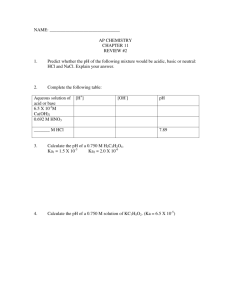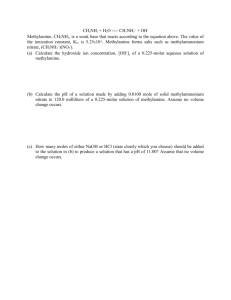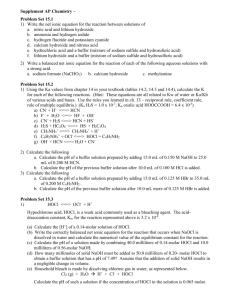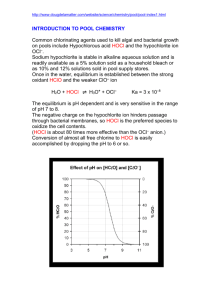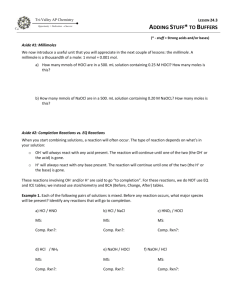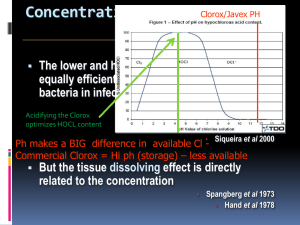ap® chemistry 2009 scoring guidelines - AP Central
advertisement
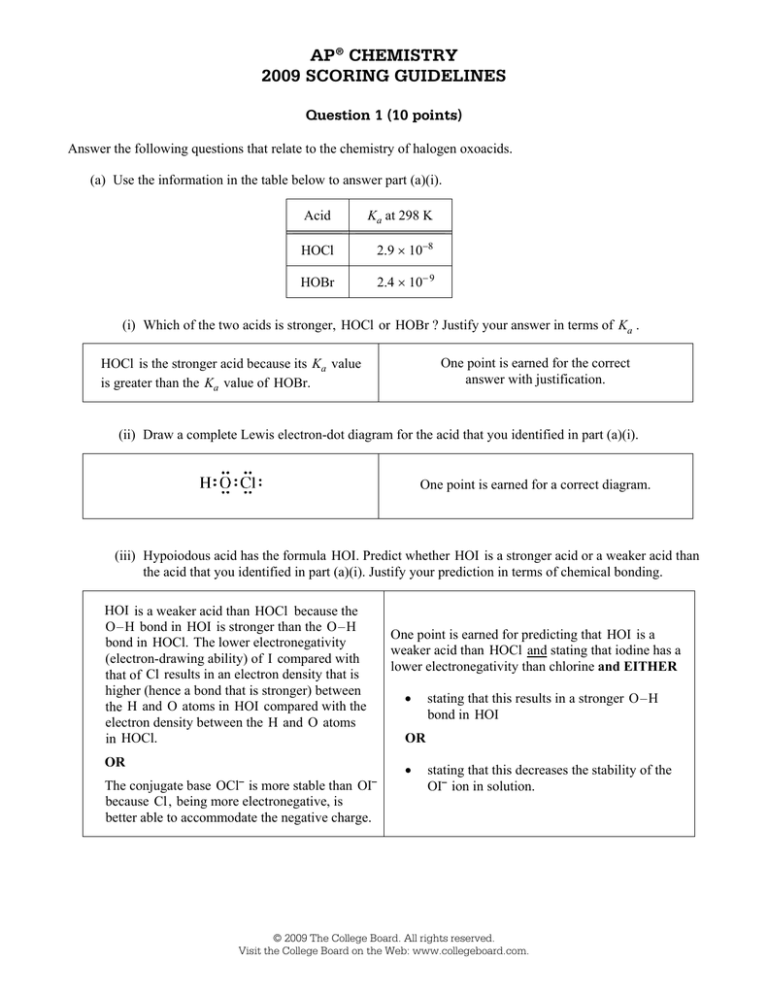
AP® CHEMISTRY 2009 SCORING GUIDELINES Question 1 (10 points) Answer the following questions that relate to the chemistry of halogen oxoacids. (a) Use the information in the table below to answer part (a)(i). Acid Ka at 298 K HOCl 2.9 × 10−8 HOBr 2.4 × 10− 9 (i) Which of the two acids is stronger, HOCl or HOBr ? Justify your answer in terms of Ka . One point is earned for the correct answer with justification. HOCl is the stronger acid because its Ka value is greater than the Ka value of HOBr. (ii) Draw a complete Lewis electron-dot diagram for the acid that you identified in part (a)(i). One point is earned for a correct diagram. (iii) Hypoiodous acid has the formula HOI. Predict whether HOI is a stronger acid or a weaker acid than the acid that you identified in part (a)(i). Justify your prediction in terms of chemical bonding. HOI is a weaker acid than HOCl because the O–H bond in HOI is stronger than the O–H bond in HOCl. The lower electronegativity (electron-drawing ability) of I compared with that of Cl results in an electron density that is higher (hence a bond that is stronger) between the H and O atoms in HOI compared with the electron density between the H and O atoms in HOCl. OR One point is earned for predicting that HOI is a weaker acid than HOCl and stating that iodine has a lower electronegativity than chlorine and EITHER • OR • The conjugate base OCl⎯ is more stable than OI⎯ because Cl, being more electronegative, is better able to accommodate the negative charge. stating that this results in a stronger O–H bond in HOI stating that this decreases the stability of the OI⎯ ion in solution. © 2009 The College Board. All rights reserved. Visit the College Board on the Web: www.collegeboard.com. AP® CHEMISTRY 2009 SCORING GUIDELINES Question 1 (continued) (b) Write the equation for the reaction that occurs between hypochlorous acid and water. HOCl + H2O Æ̈ OCl− + H3O+ One point is earned for the correct equation. OR HOCl Æ̈ OCl− + H+ (c) A 1.2 M NaOCl solution is prepared by dissolving solid NaOCl in distilled water at 298 K. The hydrolysis reaction OCl−(aq) + H2O(l) Æ̈ HOCl(aq) + OH−(aq) occurs. (i) Write the equilibrium-constant expression for the hydrolysis reaction that occurs between OCl −(aq) and H2O(l). Kb = [HOCl][OH - ] [OCl - ] One point is earned for the correct expression. (ii) Calculate the value of the equilibrium constant at 298 K for the hydrolysis reaction. Kb = Kw 1.0 × 10−14 = = 3.4 × 10−7 −8 Ka 2.9 × 10 One point is earned for the correct value with supporting work. (iii) Calculate the value of [OH −] in the 1.2 M NaOCl solution at 298 K . [OCl−] [HOCl] [OH−] initial value 1.2 0 ≈0 change −x x x 1.2 − x x x equilibrium value Khyd = 3.4 × 10−7 = ( x )( x ) [OH - ][HOCl] = (1.2 - x) [OCl ] ≈ One point is earned for the correct setup. x2 1.2 One point is earned for the correct answer with supporting calculations. ⇒ (1.2)(3.4 × 10−7) = x 2 ⇒ x = [OH−] = 6.4 × 10− 4 M © 2009 The College Board. All rights reserved. Visit the College Board on the Web: www.collegeboard.com. AP® CHEMISTRY 2009 SCORING GUIDELINES Question 1 (continued) (d) A buffer solution is prepared by dissolving some solid NaOCl in a solution of HOCl at 298 K. The pH of the buffer solution is determined to be 6.48. (i) Calculate the value of [H3O+] in the buffer solution. [H+] = 10− 6.48 = 3.3 × 10−7 M One point is earned for the correct value. (ii) Indicate which of HOCl(aq) or OCl−(aq) is present at the higher concentration in the buffer solution. Support your answer with a calculation. [H+] = 3.3 × 10−7 M and Ka for HOCl = 2.9 × 10−8 Ka = [H + ][OCl - ] [HOCl] 2.9 × 10−8 = One point is earned for the correct answer with supporting buffer calculations. (3.3 ¥ 10 -7 )[OCl - ] [HOCl] 2.9 ¥ 10 -8 [OCl - ] = = 0.088 [HOCl] 3.3 ¥ 10 -7 ⇒ [HOCl] > [OCl−] © 2009 The College Board. All rights reserved. Visit the College Board on the Web: www.collegeboard.com. 1A 1 of 2 © 2009 The College Board. All rights reserved. Visit the College Board on the Web: www.collegeboard.com. 1A 2 of 2 © 2009 The College Board. All rights reserved. Visit the College Board on the Web: www.collegeboard.com. 1B 1 of 2 © 2009 The College Board. All rights reserved. Visit the College Board on the Web: www.collegeboard.com. 1B 2 of 2 © 2009 The College Board. All rights reserved. Visit the College Board on the Web: www.collegeboard.com. 1C 1 of 2 1C 1 of 2 © 2009 The College Board. All rights reserved. Visit the College Board on the Web: www.collegeboard.com. 1C 2 of 2 © 2009 The College Board. All rights reserved. Visit the College Board on the Web: www.collegeboard.com. AP® CHEMISTRY 2009 SCORING COMMENTARY Question 1 Overview This question assessed the breadth of students’ understanding of weak acid/weak base/buffer equilibria in aqueous solution and their ability to apply the concepts to solve problems. In part (a)(i) students were required to interpret given Ka values of two halogen oxoacids to determine their relative acid strengths. In part (a)(ii) students were asked to draw a complete Lewis electron-dot diagram for one of the halogen oxoacids, and in part (a)(iii) they had to predict and justify the relative strength of a third oxoacid in terms of principles of chemical bonding. In part (b) students were asked to write a balanced chemical equation for the reaction of a weak acid in aqueous solution. In part (c) they were required to write a hydrolysis expression, calculate the value of Kb (hydrolysis equilibrium constant) from the given value of Ka, and calculate [OH−] for a solution of the conjugate base of one of the oxoacids of given concentration. Finally, in part (d) students had to determine [H3O+] in a buffer solution of given pH and to apply the definition of Ka (or the Henderson–Hasselbalch equation) to determine the relative concentrations of HOCl and OCl− in the buffer solution. Sample: 1A Score: 10 This response earned all 10 points: 1 for part (a)(i), 1 for part (a)(ii), 1 for part (a)(iii), 1 for part (b), 1 for part (c)(i), 1 for part (c)(ii), 2 for part (c)(iii), 1 for part (d)(i), and 1 for part (d)(ii). Sample: 1B Score: 8 The point was not earned in part (c)(i) because the denominator is omitted from the expression. The point was not earned in part (d)(ii) because the justification is incorrect. Sample: 1C Score: 4 The point was not earned in part (a)(i) because the response incorrectly states the relative magnitudes of the Ka values given. The point was not earned in part (a)(iii) because the statement that “[t]he stronger the bonds, the stronger the acid” is vague and incorrect. None of the possible 3 points was earned in parts (c)(ii) and (c)(iii). The point was not earned in part (d)(ii) because the justification is incorrect. © 2009 The College Board. All rights reserved. Visit the College Board on the Web: www.collegeboard.com.
